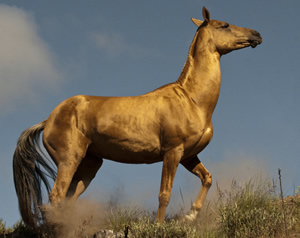History
The ancestors of the breed may date back to animals living 3,000 years ago, known by a number of names, but most often as the Nisean horse. The precise ancestry is difficult to trace, however, because prior to about 1600 AD, horse breeds in the modern sense did not exist; rather, horses were identified by local strain or type.
According to one theory of origin, the Akhal-Teke were kept hidden by tribesmen in the area where the breed first appeared, the Turkmenistan desert Kara Kum, which is a rocky, flat desert surrounded by mountains. Others claim that the horses are descendants of the mounts of Mongol raiders of the thirteenth and fourteenth century.
The breed is very similar to the now-extinct Turkoman Horse, once bred in neighboring Iran. Some historians believe that the two are different strains of the same breed. It is a disputed "chicken or egg" question whether the influential Arabian was either the ancestor of the breed or was developed out of this breed. It is also possible that the so-called "hot blooded" breeds, the Arabian, Turkoman, Akhal-Teke, and the Barb all developed from a single "oriental horse" predecessor.
Tribesmen of Turkmenistan first used the horses for raiding. They selectively bred the horses, keeping records of the pedigrees via an oral tradition. The horses were called "Argamaks" by the Russians, and were cherished by the nomads.
In 1881, Turkmenistan became part of the Russian Empire. The tribes fought with the tsar, eventually losing. The Russian general Kuropatkin developed a fondness for horses he had seen while fighting the tribesmen, founded a breeding farm after the war and renamed the horses, "Akhal-Tekes", after the Teke Turkmen tribe that lived near the Akhal oasis. The Russians printed the first studbook in 1941, which included 287 stallions and 468 mares.
The Akhal-Teke has had influence on many breeds, possibly including the Thoroughbred through the Byerly Turk (which may have been Akhal-Teke, an Arabian, or a Turkoman Horse), one of the three foundation stallions of the breed. Three other stallions, known as the "Lister Turk", the "White Turk", and the "Yellow Turk" also contributed to the foundation of the Thoroughbred breed. The Trakehner has also been influenced by the Akhal-Teke, most notably by the stallion, Turkmen-Atti, as have the Russian breeds Don, Budyonny, Karabair, and Karabakh.
The breed suffered greatly when the Soviet Union required horses to be slaughtered for meat, even though local Turkmen refused to eat them. At one point only 1,250 horses remained and export from the Soviet Union was banned. The government of Turkmenistan now uses the horses as diplomatic presents as well as auctioning a few to raise money for improved horse breeding programs. Horses are not gelded in Central Asia.
In the early twentieth century, crossbreeding between the Thoroughbred and the Akhal-Teke took place, aiming to create a faster long-distance racehorse. The Anglo Akhal-Tekes were not so resilient however, as their Akhal-Teke ancestors, and many died due to the harsh conditions of Central Asia. After the 2,600 mile endurance race from Ashkabad to Moscow in 1935, when the purebreds finished in much better condition than the part-breds, the studbook management decided to consider all crossbred horses born after 1936, as not purebred. Horses with English Thoroughbred ancestors born prior to that date were allowed to remain inside the studbook (e.g. 044 Tillyakush, grandson of Thoroughbred Burlak or 831 Makh, granddaughter of Thoroughbred Blondelli, and great-great-granddaughter of Thoroughbred Junak). Since 1973, all foals must be blood typed to be accepted in the stud book in order to protect the purity. A stallion not producing the right type of horse may be removed. The stud book was closed in 1975.






